Perched atop Greenan Mountain in the scenic Inishowen Peninsula of County Donegal, Ireland, the Grianan of Aileach is an ancient stone fort with a history that intertwines myth, royalty, and centuries of warfare. This historical landmark, dating back to the early medieval period, commands sweeping views over the counties of Donegal, Derry, and Tyrone, providing a strategic vantage point that has been coveted throughout the ages. Believed to have been built or expanded by the Northern Uí Néill dynasty around the 6th or 7th century AD, Grianan of Aileach is often associated with the much older roots of the Celtic Iron Age.
Contents
Origins and Early History
Prehistoric Roots and Mythological Associations
The Grianan of Aileach’s story begins in the mists of prehistory, with evidence suggesting that the hilltop site was significant long before the construction of the stone fort. The site is steeped in Irish mythology, particularly linked to the Tuatha Dé Danann, a supernatural race believed to have inhabited Ireland before the arrival of humans. According to legend, the Grianan of Aileach was constructed or enhanced by the Dagda, a god-like figure and chief of the Tuatha Dé Danann, as a burial place for his son. This mythological association imbues the site with a sense of ancient sanctity and mystery, suggesting that it may have served as a ceremonial or ritual site even before it became a fort.
Archaeological Evidence of Early Settlement
Archaeological findings around Grianan of Aileach indicate that the area was in use by communities long before the documented construction of the stone fortification. Items and artifacts found in the vicinity suggest that the location was chosen for its strategic advantages—high elevation and clear views of the surrounding landscape—and its natural resources. These early settlers may have used the site as a seasonal gathering place, for ritual purposes, or as a defensive stronghold against rival tribes.
The physical evidence includes remnants of domestic tools, pottery, and early metalwork, pointing to a continuity of settlement that likely spans the late Bronze Age through the Iron Age. This pre-fort usage underscores the site’s importance in the regional socio-economic and cultural exchanges that characterized prehistoric Ireland.
Transition to a Fortified Site
The transition from a loosely settled or ceremonial site to a fortified stronghold is not well-documented but is believed to have occurred as the local tribal structures evolved into more complex societal organizations. The need for more permanent and defensive structures would have grown as the local population increased and as the political landscape of the region became more contested. The construction of the stone fort, as attributed to the early medieval period, marks a significant shift in the usage of the site—from a place of mythological and ceremonial importance to a symbol of political and military power.
Construction and Architectural Details
Construction Timeline and Techniques
The stone fort that stands today at Grianan of Aileach is estimated to have been constructed or extensively rebuilt in the 6th or 7th century AD, although elements of the site may be much older. This period marks a significant phase in Irish history, where stone was increasingly used for the construction of royal fortifications and religious structures. The fort’s construction is attributed to the powerful Northern Uí Néill dynasty, who sought to establish a formidable royal seat that demonstrated their authority and control over the region.
The methods used in the construction of Grianan of Aileach reflect the sophisticated dry-stone walling techniques of the time. These techniques involved fitting large stones together without the use of mortar, a testament to the skill and precision of the builders. This method not only provided substantial durability but also allowed for flexibility in the structure, an important feature in the damp and variable Irish climate.
Architectural Design of the Fort
The Grianan of Aileach is a classic example of an Irish ringfort but on a grander scale, indicative of its royal status. The fort is circular in plan, approximately 23 meters in diameter, and is surrounded by three concentric earthen bank enclosures, which would have enhanced its defensive capabilities.
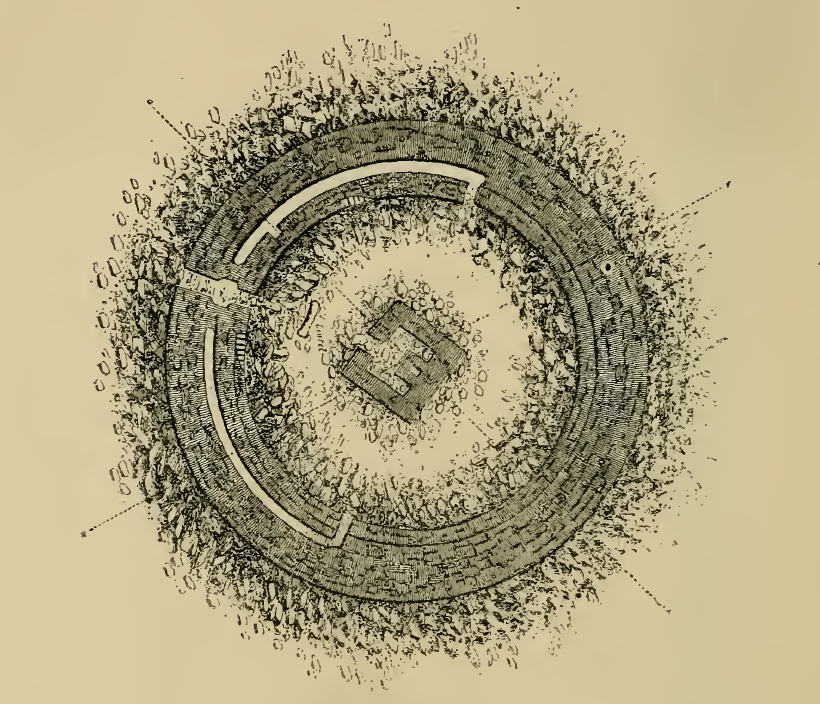
Walls
The fort’s most striking feature is its massive stone walls, which are about 4 to 5 meters high and up to 4.5 meters thick at the base. These walls are constructed from local mica-schist, which glistens slightly in the sunlight, adding to the fort’s imposing appearance. The construction allows for a narrow walkway along the top, which would have served both as a lookout and a defensive platform.
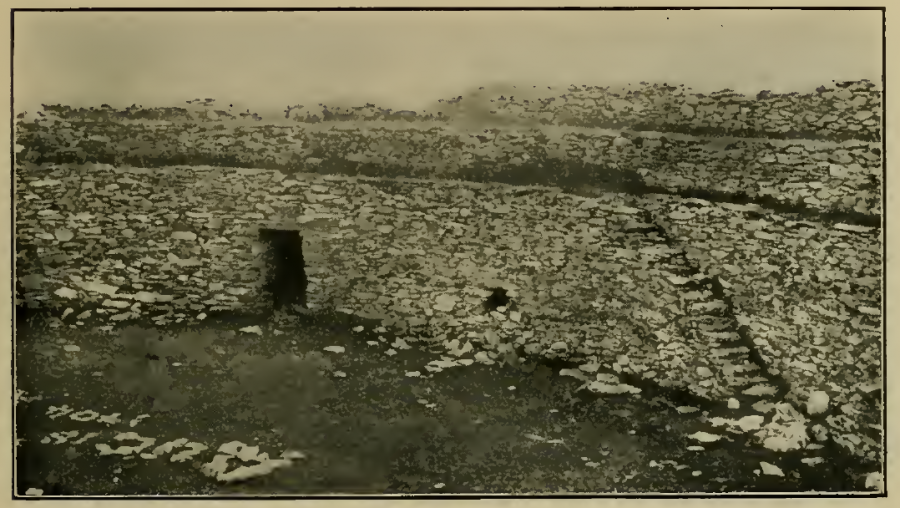
Terraces and Internal Features
Internally, the fort is divided into terraces, accessed by a series of steps built into the thickness of the wall. This design not only maximizes the internal space within the fort but also provides strategic defensive positions. The terraces likely supported wooden structures during the fort’s occupation, serving as dwellings, storerooms, or meeting spaces for the royal court.
The entrance to the fort is a narrow passageway, ingeniously designed to reduce the risk of direct assault. This gateway is lintelled and offset, forcing anyone entering to expose their left side, which would be a disadvantage to right-handed attackers, assuming most would wield a sword in their right hand.
Souterrains
Another notable feature is the presence of souterrains – underground passages and chambers that likely served as food storage areas or as places of refuge during attacks. These features underline the sophistication of the fort’s design, combining everyday functionality with defensive necessities.
Royal Seat and Political Significance
Center of Power: The Cenél nEógain
The Grianan of Aileach’s transformation into a formidable royal seat and political center is largely attributed to its association with the Cenél nEógain, a leading branch of the Northern Uí Néill. This lineage, descended from Niall of the Nine Hostages—one of Ireland’s most legendary High Kings—played a pivotal role in shaping the political landscape of early medieval Ireland. The fort’s strategic location on Greenan Mountain allowed the rulers of Cenél nEógain to oversee vast territories across what is now modern-day Ulster, providing both military advantage and a symbol of enduring authority.
Political Significance and Historical Mentions
The fort is repeatedly mentioned in various historical annals, highlighting its importance through the centuries. These include the Annals of the Four Masters, the Annals of Ulster, and others, which document its central role in the socio-political dynamics of the region. Grianan of Aileach was not only a military stronghold but also a site of significant ceremonial importance, where kings were inaugurated and strategic alliances were forged.
Inauguration Site
One of the key aspects of Grianan of Aileach’s political significance was its use as an inauguration site. This ceremonial role is deeply emblematic, linking the fort with the divine right to rule and the continuity of leadership within the Northern Uí Néill. The ritual of inauguration, often imbued with both Christian and earlier pagan traditions, underscored the sacred nature of kingship and the fort’s role as a touchstone for royal authority.
Regional Dominance
Throughout its history, the fort served as a hub for regional governance and a place from which the kings of Cenél nEógain exerted their influence over northern Ireland. Its location provided strategic control over the approaches from the north and east, particularly against rival clans and later, Viking invaders. The annals record numerous battles and political events centered around the fort, illustrating its importance in military strategy and defense.
Decline and Destruction
The political significance of Grianan of Aileach endured until it was strategically dismantled in 1101 by Muirchertach Ua Briain, King of Munster, in a symbolic act meant to curtail the power of the Northern Uí Néill. This event marked a significant turning point in the fort’s history, leading to its decline as a political center. Despite this, its legendary status continued to grow, fueled by its rich history and its appearances in tales and lore.
Viking and Medieval Assaults
Viking Raids
During the 9th and 10th centuries, Grianan of Aileach faced increasing threats from Norse invaders, who targeted Ireland’s rich monastic sites and vulnerable coastal settlements. The strategic location of the fort, with commanding views over Lough Foyle and Lough Swilly, made it an appealing target for these seafaring raiders from Scandinavia. The fort’s robust defenses and strategic positioning, however, made it a formidable challenge, although it did not escape the Vikings’ attention. The annals recount several occasions when Viking forces targeted the fort, underscoring its importance and the ongoing conflict during this era.
The Destruction by Muirchertach Ua Briain
The most significant event in the later history of Grianan of Aileach was its calculated destruction in 1101 by Muirchertach Ua Briain, King of Munster. This deliberate act was a strategic and symbolic gesture intended to diminish the power of the Northern Uí Néill and assert his dominance over the northern territories.
According to historical accounts, Ua Briain’s forces dismantled the fort with meticulous thoroughness, removing stones and effectively rendering the structure defenseless. This was not merely a physical demolition but a pointed effort to erase the symbolic and literal stronghold of his rivals. The destruction of Grianan of Aileach was emblematic, a means to undermine the Northern Uí Néill’s claim to royal authority and to shift the power dynamics in favor of Munster. This act was part of a broader campaign of asserting control that included several other strategic locations across the north.
Subsequent Decline
Following its intentional dismantlement, Grianan of Aileach entered a period of rapid decline, both in terms of its physical structure and its political significance. Deprived of its royal patronage and military importance, the fort was left to decay, gradually being overtaken by the natural landscape and reduced to ruins. This physical decline symbolized the end of its era as a major political and military stronghold.
Over the subsequent centuries, the fort’s role shifted from a vibrant center of power to a historical relic, revered more for its mythological and historical significance than for any contemporary political or military role. As newer political structures and urban centers emerged in medieval Ireland, particularly under Norman influence, Grianan of Aileach transitioned into a symbol of a bygone era, its legends and history echoing a once-glorious past.
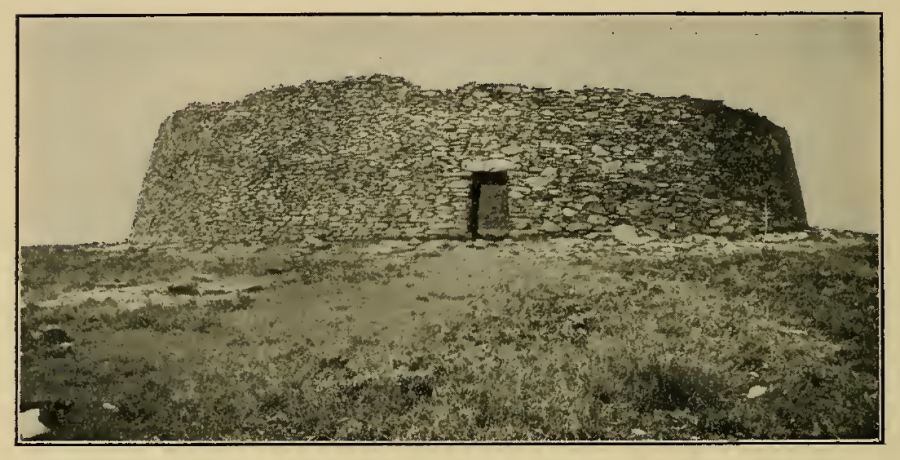
Archaeological Surveys and Restoration
Nineteenth-Century Archaeological Interest
The nineteenth century marked a period of renewed interest in Ireland’s archaeological heritage, with Grianan of Aileach drawing particular attention from historians and archaeologists. Among these was George Petrie, a prominent Irish archaeologist and historian, who played a crucial role in the study and preservation of Irish antiquities. Petrie conducted extensive surveys at Grianan of Aileach and was instrumental in documenting its structure and significance in great detail. His work not only highlighted the architectural and historical importance of the fort but also helped ignite a broader public interest in the preservation of Irish heritage sites.
Petrie’s surveys, carried out in the 1830s, were among the first to provide a systematic description of the fort’s features, from its imposing stone walls to its intricate internal terraces. His meticulous drawings and descriptions provided a baseline for future restoration efforts and remain valuable resources for understanding the site’s original state and subsequent changes.
The 1870s Restoration by Dr. Walter Bernard
Following the archaeological interest spurred by figures like George Petrie, the 1870s saw a significant restoration effort led by Dr. Walter Bernard, a physician and local historian from Derry. Driven by a combination of nationalistic fervor and a romantic interest in Ireland’s Gaelic past, Bernard undertook the restoration of Grianan of Aileach with the aim of returning it to its former glory.
Bernard’s approach to restoration involved reconstructing the fort’s collapsed sections and reinforcing its existing structures. While his efforts were guided by the best intentions and the archaeological understandings of his time, the techniques and materials used were not always consistent with the fort’s original construction methods. This led to criticisms from later archaeologists and historians regarding the accuracy and authenticity of the restoration.
Despite these critiques, Bernard’s work had a profound impact on the fort’s current appearance. The restoration solidified Grianan of Aileach as a symbol of Irish heritage and a tangible connection to the past. It also made the site more accessible and understandable to the public, helping to establish it as an important tourist attraction and educational resource.
Impact on the Fort’s Current Appearance
Today, much of what visitors see at Grianan of Aileach reflects the 19th-century restoration. The walls, although partly reconstructed, still convey the grandeur and strategic ingenuity of the original fortification. While the restoration may not have entirely adhered to the fort’s original building practices, it has nonetheless played a crucial role in preserving the site from further decay and in keeping the story of Grianan of Aileach alive for future generations.
Modern Era and Preservation
Recent Conservation Efforts
In the modern era, Grianan of Aileach has been recognized as a site of significant historical and cultural importance, warranting ongoing preservation efforts to maintain its integrity and stability. As a designated national monument, it is protected under the National Monuments Acts, which ensure that any work or changes to the site are carefully managed to preserve its historical value. Recent conservation efforts have focused on stabilizing the structure, preventing further erosion, and addressing issues caused by exposure to the elements and the impact of increased visitor numbers.
These efforts often involve multidisciplinary teams including archaeologists, conservation specialists, and historians, ensuring that the work is informed by the best available knowledge and techniques. This collaborative approach helps to maintain the authenticity of the fort’s remaining structures while ensuring its longevity for future generations to explore and learn from.
The Fort as a Tourist Destination
Grianan of Aileach has become a popular tourist destination, attracting visitors from around the world who come to marvel at its ancient stone walls and enjoy the panoramic views it offers of the surrounding Irish countryside. The site’s accessibility has been enhanced with visitor facilities and interpretative signage that provide insights into its rich history and the broader context of Ireland’s archaeological heritage. These amenities help to make the fort a compelling destination for both casual tourists and those with a keen interest in history and archaeology.
The fort’s elevated position offers unmatched vistas of counties Donegal, Derry, and Tyrone, making it a picturesque spot that appeals to photographers and nature enthusiasts alike. Its presence on many regional travel itineraries underscores its importance as a cultural landmark and highlights the role of tourism in promoting local history and supporting the regional economy.
Cultural Significance Today
Today, Grianan of Aileach is celebrated not only as a monument of historical significance but also as a symbol of Irish cultural identity and resilience. The site features prominently in local folklore and cultural expressions, embodying themes of resistance, endurance, and the deep-rooted connections of the Irish people to their land and history. Events and reenactments at the fort also help to bring its history to life, providing a tangible connection to the past that is both educational and engaging.
Additionally, the fort’s role in academic and educational fields continues to grow as it serves as a case study in courses related to archaeology, history, and heritage management. These academic pursuits ensure that Grianan of Aileach remains relevant in scholarly discussions about medieval Ireland, contributing to ongoing debates and research about its origins, usage, and the broader historical context of the region.
Folklore and Legends
Myths of the Dagda and the Tuatha Dé Danann
Grianan of Aileach is steeped in the rich tapestry of Irish mythology, most notably its association with the Dagda, one of the most prominent gods of the Tuatha Dé Danann. According to legend, the Dagda, renowned for his supernatural powers and wisdom, chose this commanding site for its strategic and mystical significance. The fort is said to have been built around the grave of his son, Aedh, creating a sacred space that bridged the mortal world with the spiritual.
The fort is also linked to other mythological figures and events, imbuing it with a layer of mystical significance that goes beyond historical and archaeological facts. These stories often highlight the site as a center of power, not just in a political or military sense, but also in a cosmic or divine framework, suggesting that it was considered a liminal space where different realms intersected.
Local Folklore and Legends
Over the centuries, Grianan of Aileach has accumulated a wealth of folklore that continues to enchant and engage those who visit. One popular tale tells of how the stones of the fort whisper the secrets of the ancient kings to those who listen closely, especially at dusk and dawn. Another legend claims that the fort is the sleeping place of ancient warriors who are destined to wake and defend Ireland in the hour of its greatest need.
Local folklore also often reflects the historical invasions and battles associated with the site, with tales of sieges, betrayals, and heroic defenses that echo the documented events of its past. These stories serve to enhance the mystique of the fort and root it deeply in the local consciousness as a symbol of endurance and Irish identity.
Cultural Resonance Today
The folklore and legends of Grianan of Aileach resonate strongly in contemporary culture, making it a symbol of Ireland’s rich mythical heritage. The site is frequently referenced in literature, music, and art that seek to capture the essence of Irish historical and mythical landscapes. Its stories are passed down through generations, keeping the legend alive and reinforcing the cultural identity and continuity of the community.
Moreover, the fort’s mythological associations play a significant role in festivals and cultural events in the area, which often draw on these ancient tales to frame celebrations of Celtic history and spirituality. These events not only attract tourists but also serve as a focal point for community pride and cultural preservation.
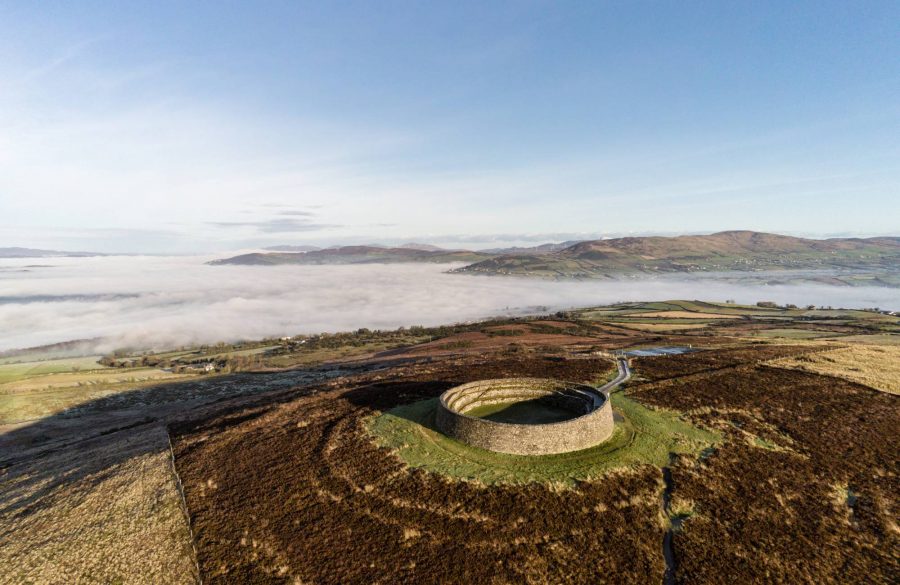


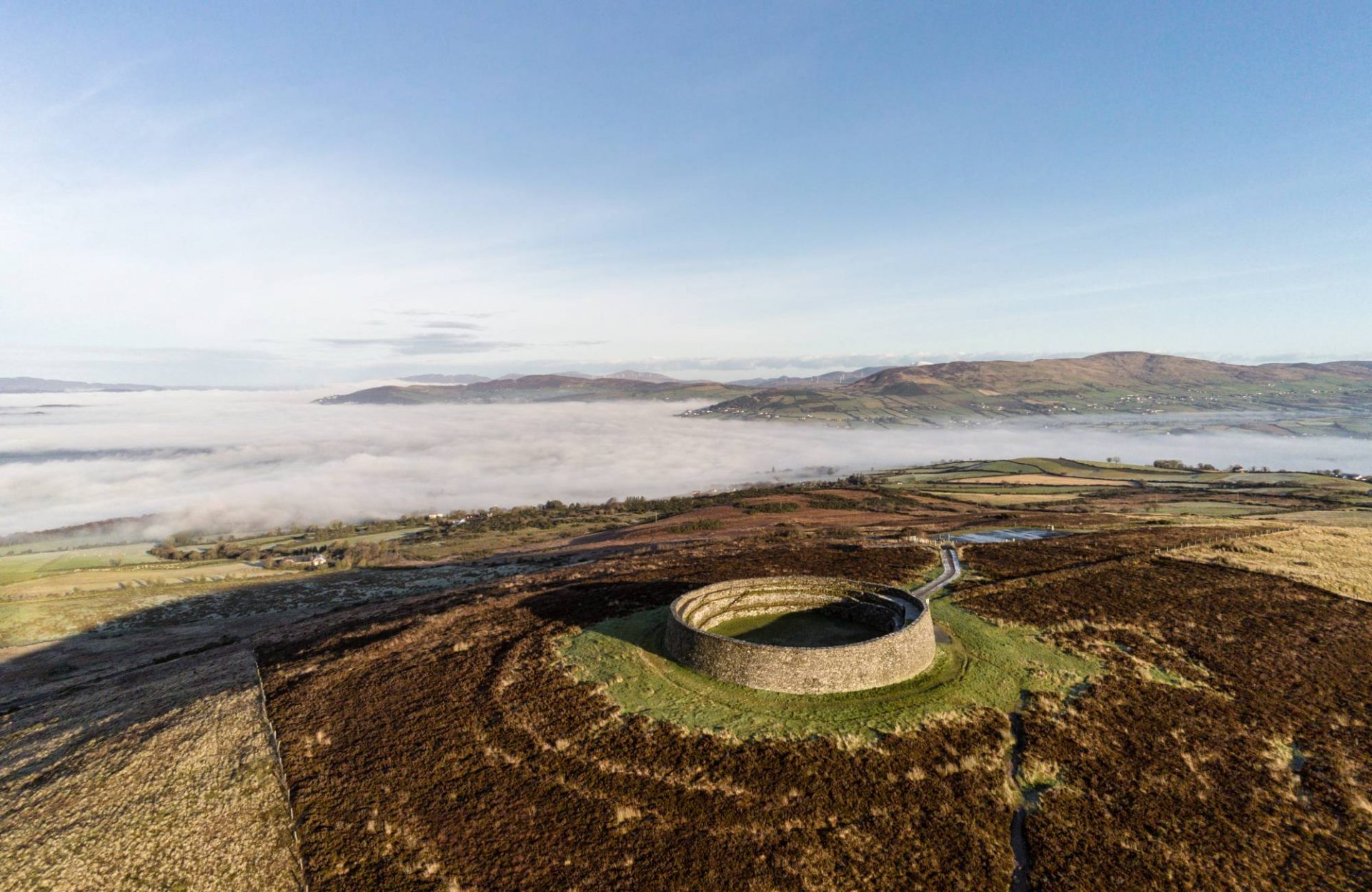
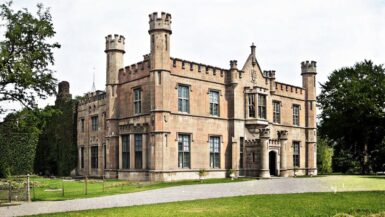
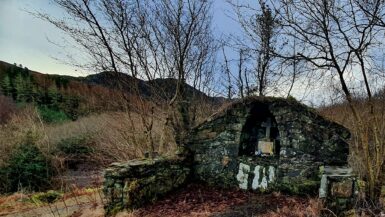
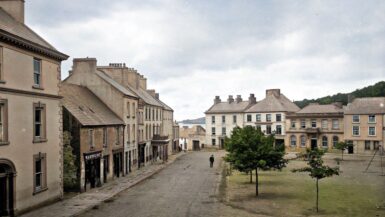
Leave a reply